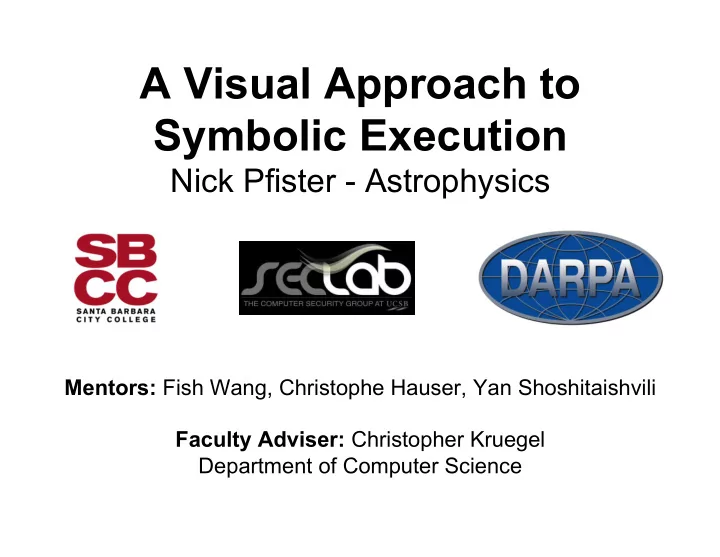

A Visual Approach to Symbolic Execution Nick Pfister - Astrophysics Mentors: Fish Wang, Christophe Hauser, Yan Shoshitaishvili Faculty Adviser: Christopher Kruegel Department of Computer Science
Our safety depends on software! What happens if this software fails? We may analyze software using Symbolic Execution to... Examine how software works Detect vulnerabilities Detect malicious software - aka malware
Why Symbolic Execution? 2 Types of Analysis X = 1 Dynamic Analysis X = 2 Runs program many times X with many different inputs = 3 Static Analysis Examines the source code of a program, but doesn’t execute it Symbolic Execution , a type of Static Analysis, inputs an abstract variable and solves the value for all pathways
Visualizing Symbolic Execution Each box will contain useful information Arrows will be used to illustrate control flow Graphs will be interactive Control Flow Graph (CFG)
Objectives ANGR Symbolic Execution System Frontend Backend “Visual/Abstract end” “Operational End” With no connection, these are not useful With a little coding, we can create a connection!
Identify and Evaluate Useful Libraries Useful visual and backend libraries already exist Determine what works best for our application GraphDracula JSPlumb
Implement Libraries ANGR Symbolic Execution System Backend Software
Experimental Data We can measure the effectiveness of our visualizations by examining it’s speed and usability Visual Application Average Loading time (20 trials): 5.15ms max: 11.03ms min: 4.09ms A 5ms loading time is negligible when compared to the backend processing time As this interface improves to handle more complex graphs, loading time will have to be re-assessed
Interface Snapshot of our web- based user interface Our interface will be user-friendly and easy to understand
Interface Preliminary Interface at startup (test without program data) Connections are unclear Containers are small/lacking detail
Interface Interface after first revision (test without program data) Containers can be reorganized by user Connections are more visible Containers are still small and not interactive
Interface Interface after most recent revision Improved connections Resizable containers Improved graph organization
Future Plans This interface is part of a much larger project, and will continue to be improved The coding behind this interface is currently being implemented by researchers in the SecLab to visualize CFGs at DEFCON Additional revisions to the interface are planned to make generate graphs of larger, more complex programs
Achievements Previous computer skills: Java, C, C++ To create this interface, I had to learn... HTML/CSS for website layout/styling JavaScript/jQuery for graph generation Python for backend development Git/GitLab use for sharing and merging code
Achievements Continued... Most importantly,developing this software has given me first-hand experience with... Organization/planning Experimental methods Trial and error “I have not failed. I have just found 10,000 ways that won’t work.” -Thomas Edison
Acknowledgements Special thanks to... Mentors Fish Wang, Christophe Hauser, and Yan Shoshitaishvili Faculty Advisor Christopher Kruegel INSET Maria Napoli, Jens-Uwe Kuhn, Nick Arnold, my fellow interns, and everyone else involved In addition, Todd Brei, Mike Young, Stephen Strenn, and Jerry Wyss for nurturing my interest in math and science
Recommend
More recommend